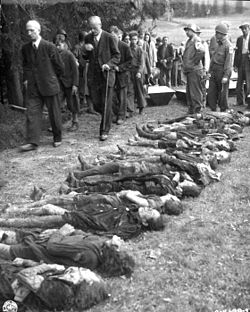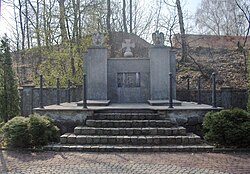Death marches during the Holocaust

The death marches (Todesmärsche in German) refer to the forcible movement between Autumn 1944 and late April 1945 by Nazi Germany of hundreds of thousands of prisoners from Nazi concentration camps and prisoner of war camps near the eastern front to camps inside Germany away from front lines and allied forces. This was both to remove evidence from concentration camps and to prevent the repatriation of POWs.
General


Toward the end of World War II in 1944, forces of the Britain and the United States advanced from the west, while forces of the Soviet Union advanced from the east. Trapped in the middle, the SS -- not wanting the world to know about the Holocaust -- decided to abandon the camps, moving or destroying evidence of the various atrocities they had committed there. Thousands of prisoners were killed in the camps before the marches commenced. These executions were deemed crimes against humanity during the Nuremberg trials.
Although most of the prisoners were already very weak or ill after enduring the routine violence, overwork and starvation of concentration camp or prison camp life, they were marched for dozens of miles in the snow to railway stations, then transported for days at a time without food, water or shelter in freight carriages originally designed for cattle. On arrival at their destination, they were then forced to march again to new camps. Prisoners who were unable to keep up due to fatigue or illness were usually executed by gunshot.
The first evacuation of Majdanek inmates started in April 1944. Prisoners of Kaiserwald were transported to Stutthof or killed in August. Mittelbau-Dora was evacuated in April 1945.[1]
The SS killed large numbers of prisoners by starvation before the marches, and shot dead many more both during and after the death marches for not being able to keep pace. Seven hundred prisoners were killed during one ten-day march of 8,000 Jews, including 6,000 women, who were being moved from camps in the Danzig region, which is bordered on the north by the Baltic Sea. Those still alive when the marchers reached the coast were forced into the sea and shot.[2]
Elie Wiesel, Holocaust survivor and winner of the 1986 Nobel Peace Prize, was forced on a death march, along with his father, Chlomo, from Buna to Buchenwald, which he describes in his 1958 book Night.[3]
Auschwitz to Wodzisław Śląski
The best known of the death marches took place in January 1945, when the Soviet army advanced on occupied Poland. Nine days before the Soviets arrived at the death camp at Auschwitz, the SS marched nearly 60,000 prisoners out of the camp toward Wodzisław Śląski (German: Loslau), 35 miles away, where they were put on freight trains to other camps. Approximately 15,000 prisoners died on the way.[4][5]
Stutthof to Lauenburg
The evacuation of prisoners from the Stutthof camp system in northern Poland began in January 1945. About 5,000 prisoners from Stutthof subcamps were marched to the Baltic Sea coast, forced into the water, and machine gunned. The rest of the prisoners were marched in the direction of Lauenburg in eastern Germany. They were cut off by advancing Soviet forces. The Germans forced the surviving prisoners back to Stutthof. Marching in severe winter conditions and treated brutally by SS guards, thousands died during the march. In late April 1945, the remaining prisoners were removed from Stutthof by sea, since Stutthof was completely encircled by Soviet forces. Again, hundreds of prisoners were forced into the sea and shot. Over 4,000 were sent by small boat to Germany, some to the Neuengamme concentration camp near Hamburg, and some to camps along the Baltic coast. Many drowned along the way. Shortly before the German surrender, some prisoners were transferred to Malmo, Sweden, and released to the care of that neutral country. It has been estimated that over 25,000 prisoners, one in two, died during the evacuation from Stutthof and its subcamps. One hundred prisoners were liberated from Stutthof on May 9, 1945.[6]
See also
- March of the Living
- Death march
- The March (1945) of Allied POWs
Bibliography
- Hitler's Willing Executioners: Ordinary Germans and the Holocaust (reprint ed.). Vintage. January 28, 1997. ISBN 978-0-679-77268-2.
References
- ^ "Death Marches". U.S. Holocaust Memorial Museum. Retrieved 2013-06-24.
- ^ "Stutthof". U.S. Holocaust Memorial Museum. Retrieved 2013-06-24.
- ^ Wiesel, Elie. Night. New York:Hill & Wang, 1960. Originally published as La Nuit by Les Editions de Minuit, 1958.
- ^ [http://www.ushmm.org/outreach/dmarch.htm "Death marches", United States Holocaust Memorial Museum.
- ^ Martin Gilbert (May 199). Atlas of the Holocaust (map of forced marches). William Morrow & Company. ISBN 0688123643.
{{cite book}}: Check date values in:|date=(help) - ^ "Stutthof". U.S. Holocaust Memorial Museum. Retrieved 2013-06-24.
External links
- Map (from the U.S. Holocaust Memorial Museum)
- A map of the Death March of Brandenburg, by Iwo Cyprian Pogonowski
- Todesmarsch Dachau about death marches of Dachau, Kaufering, Mühldorf and Allach ( German language )
- Todesmarsch Dachau about death marches of Dachau, Kaufering, Mühldorf and Allach, includes route map
